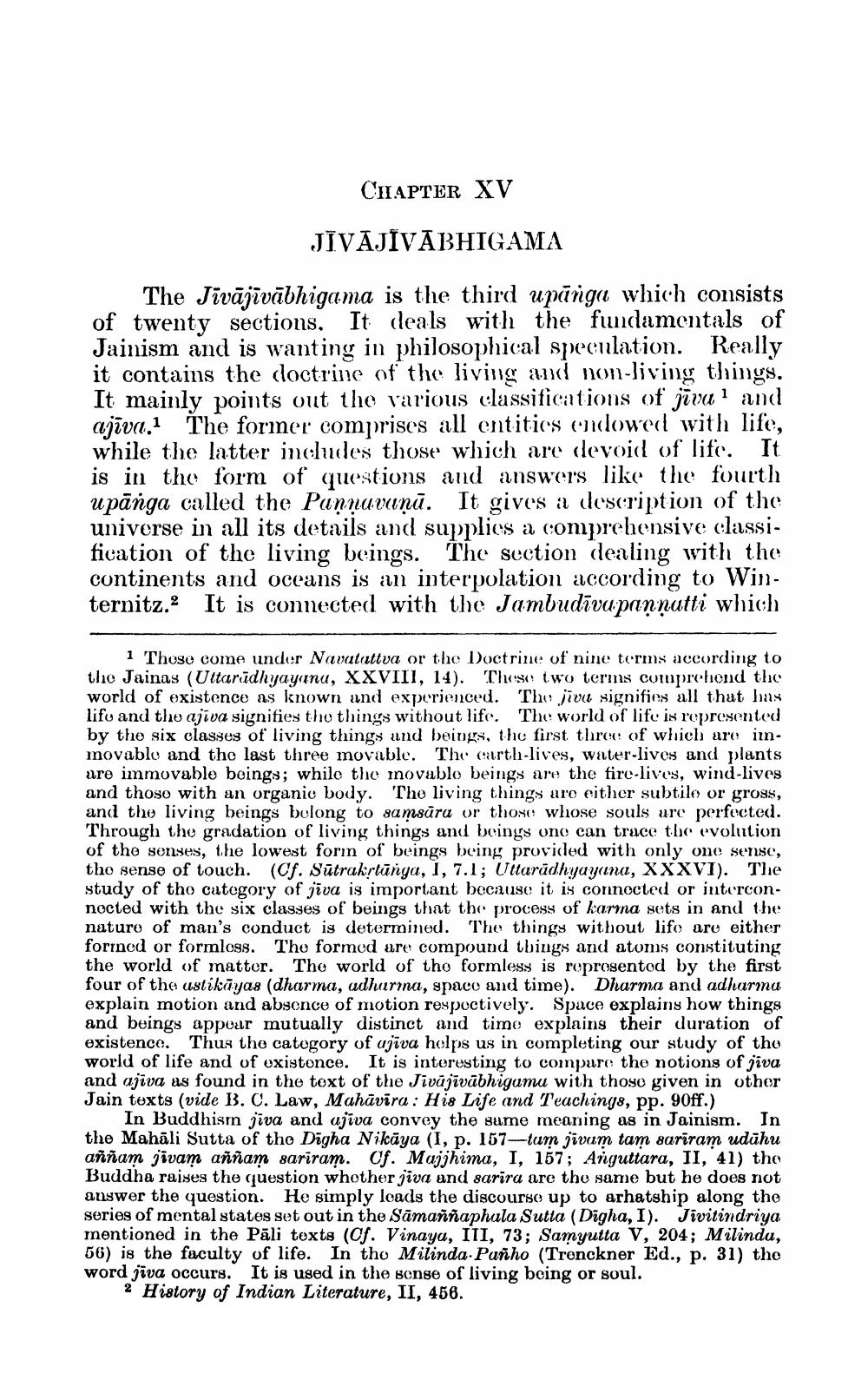________________
CHAPTER XV
JĪVĀJĪVĀBHIGAMA
The Jīvājīvābhigama is the third upanga which consists of twenty sections. It deals with the fundamentals of Jainism and is wanting in philosophical speculation. Really it contains the doctrine of the living and non-living things. It mainly points out the various classifications of jīvu 1 and ajīva.1 The former comprises all entities ondowed with life, while the latter includes those which are devoid of life. It is in the form of questions and answers like the fourth upānga called the Pannuvaņā. It gives it description of the universe in all its details and supplies a comprehensive classification of the living beings. The section dealing with the continents and oceans is an interpolation according to Winternitz.2 It is connected with the Jambudīvu pannutti which
the things like. The being
1 Thoso come under Navatattva or the Doctrine of nine terms according to thio Jainas (Uttaradhyayanu, XXVIII, 14). These two terms comprehend the world of existence as known and experienced. The jīvu signifies all that has lifu and the ajīva signifies the things without life. The world of life is represented by the six classes of living things and beings, the first three of which are iinmovable and the last three movable. The carth-lives, water-lives and plants ure immovable beings; while the movable beings are the fire-lives, wind-lives and thoso with an organic body. The living things are either subtilo or gross, and the living beings bolong to samsūra or those whose souls are perfected. Through the gradation of living things and beings one can trace the evolution of the senses, the lowest forin of beings being provided with only one sense, the sense of touch. (Cf. Sūtrakrtūnya, 1, 7.1; Uttarādhyayana, XXXVI). The study of tho category of jiva is important because it is connected or interconnocted with the six classes of beings that the process of karna sets in and the nature of man's conduct is determined. The things without life are either formed or formloss. The formed are compound things and atoms constituting the world of matter. The world of the formless is reprosentod by the first four of the astikayas (dharma, adharina, space and time). Dharma and adharma explain motion and absence of motion respectively. Space explains how things and beings appour mutually distinct and timo explains their duration of existence. Thus the catogory of ujīva helps us in completing our study of tho world of life and of existence. It is interesting to compare the notions of jiva and ajiva as found in the text of the Jivājīvābhigumu with those given in other Jain texts (vide B. C. Law, Mahāvīra : His Life and Teachings, pp. 90ff.)
In Buddhism jiva and asiva convey the same meaning as in Jainism. In the Mahāli Sutta of the Digha Nikāya (1, p. 157-tum jivum tam sariram udūhu aññam jivam aññam sariram. Cf. Majjhima, I, 157; Anguttara, II, 41) the Buddha raises the question whether jiva and sarira are the same but he does not answer the question. He simply loads the discourse up to arhatship along the series of mental states set out in the Samaññaphala Sutta (Digha, I). Jivitindriya mentioned in the Pāli texts (cf. Vinaya, III, 73; Samyutta V, 204; Milinda, 56) is the faculty of life. In tho Milinda-Punho (Trenckner Ed., p. 31) tho word jiva occurs. It is used in the sense of living being or soul.
2 History of Indian Literature, II, 456.
and beings thus the category. It is intarivābhigumu wachings, pp. Join




